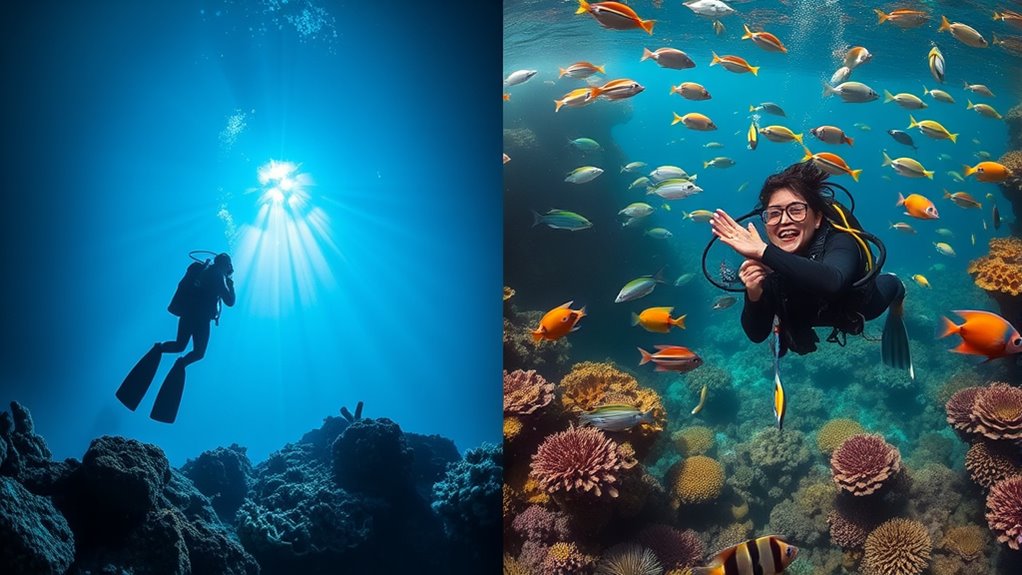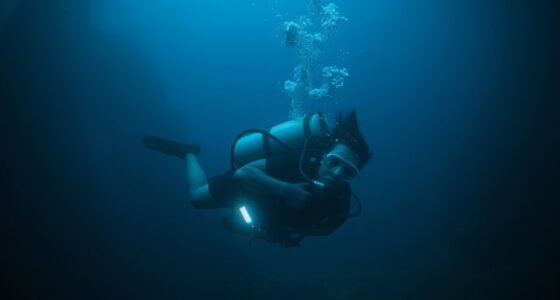Deep diving offers thrilling exploration beyond 130 feet but comes with serious risks. You’ll face potential nitrogen narcosis and decompression sickness that aren’t typically issues in recreational diving. Specialized gear is a must, along with advanced training on safety protocols and gas management. Team dynamics play a vital role too, ensuring communication and support during dives. Understanding these factors makes deep diving rewarding, and you’ll discover even more about its challenges and benefits ahead.
Key Takeaways
- Deep diving exceeds recreational limits, requiring specialized training and equipment to manage unique risks associated with greater depths.
- Increased risks of nitrogen narcosis and decompression sickness make deep diving more hazardous than recreational diving.
- Specialized gear, such as advanced suits and rebreathers, is essential for deep diving to handle high-pressure environments.
- Team dynamics are crucial in deep diving, with effective communication and shared responsibilities enhancing safety during complex dives.
- The rewards of deep diving include exploring less familiar environments and experiencing unique underwater landscapes not accessible through recreational diving.

Have you ever wondered how deep diving differs from recreational diving? While both activities let you explore the underwater world, they come with distinct challenges and requirements. If you’re considering taking the plunge into deep diving, it’s vital to understand what sets it apart from your typical dive.
Deep diving generally involves diving to depths beyond the recreational limits of 130 feet. When you go deeper, you face unique risks, including nitrogen narcosis and decompression sickness. To safely navigate these depths, you’ll need specialized training and technical equipment. You can’t just throw on your usual gear and hope for the best. Instead, you’ll require advanced diving suits, multiple gas mixtures, and sometimes even rebreathers to help manage your breathing gases effectively. This equipment is designed to guarantee you can explore deeper waters while minimizing the risks associated with increased pressure. Additionally, just as HEPA filtration is critical for capturing small particles effectively in air purifiers, understanding the importance of proper gas management is essential for maintaining safety while deep diving.
Deep diving requires specialized training and advanced equipment to manage risks like nitrogen narcosis and decompression sickness effectively.
In recreational diving, you typically use standard gear and follow straightforward protocols. You’re often diving in familiar environments, like coral reefs or shallow wrecks, and you may only need basic skills to enjoy the experience. However, in deep diving, you’ll need to be more vigilant. Alongside your technical equipment, you’ll also need to master emergency protocols. These protocols are essential to guarantee your safety and the safety of your dive team. For instance, knowing how to execute a controlled ascent or manage a gas switch in an emergency can be life-saving.
Moreover, deep diving often requires a team approach. You won’t just be responsible for your own safety; you’ll need to communicate effectively with your dive buddies and share responsibilities. Everyone must know the emergency protocols to handle unexpected situations. When you dive deep, the stakes are higher, and a well-prepared team can make all the difference.
Frequently Asked Questions
What Are the Best Locations for Deep Diving?
For the best deep diving locations, check out the Great Barrier Reef in Australia for its stunning marine biodiversity and vibrant underwater topography. You’ll also love the Blue Hole in Belize, where you can explore unique geological formations. The Red Sea in Egypt offers crystal-clear waters and diverse marine life, while the Socorro Islands in Mexico are famous for encounters with large pelagic species. Each spot promises unforgettable experiences and breathtaking underwater views.
How Much Does Deep Diving Equipment Cost?
Deep diving equipment can range from $1,000 to over $5,000, depending on the specialized gear you choose. You’ll need essentials like a dive computer, regulator, and wetsuit, each with varying price points. Don’t forget about accessories like tanks and buoyancy control devices, which add to your cost considerations. Investing in quality gear is vital for safety and performance, so it’s worth taking the time to research and find what suits your diving needs best.
Can Recreational Divers Also Go Deep Diving?
Yes, you can go deep diving as a recreational diver, but safety considerations are vital. You’ll need specialized training and equipment requirements that go beyond basic recreational diving gear. It’s not just about depth; it’s about understanding the risks involved, like decompression sickness. If you’re drawn to exploring deeper waters, consider taking a certification course to guarantee you’re well-prepared and safe, allowing you to enjoy the wonders below while minimizing potential dangers.
What Certifications Are Needed for Deep Diving?
To explore thoroughly, you’ll need specific certifications like PADI’s Deep Diver or TDI’s Advanced Nitrox. These programs provide technical training that covers advanced dive planning and safety protocols. You’ll also have to upgrade your equipment, including specialized tanks and dive computers, to handle deeper depths safely. Always make sure you’ve logged enough dive experience beforehand, and don’t skip the essential knowledge needed for safe deep diving adventures.
How Does Altitude Affect Diving Safety?
Altitude can play a sneaky role in diving safety. When you ascend to higher altitudes, the pressure effects on your body change, which can lead to altitude sickness if you’re not careful. It’s essential to give yourself time to acclimate before diving again, as your body needs to adjust to different pressures. Always monitor how you feel, and don’t rush your dives, ensuring a safer and more enjoyable underwater experience.
Conclusion
In the grand ocean of diving, each choice is a wave that shapes your journey. Deep diving, like venturing into the abyss, offers treasures unseen but demands respect and preparation. Recreational diving, akin to frolicking in sunlit shallows, invites joy and discovery without the weight of the deep. Choose your adventure wisely, for every dive is a story waiting to unfold, and whether you chase the depths or dance in the shallows, the ocean’s embrace is yours to explore.










